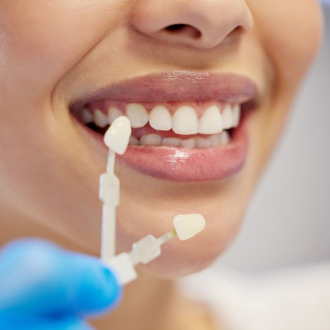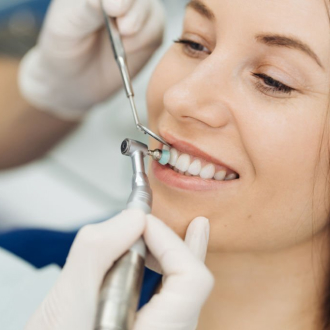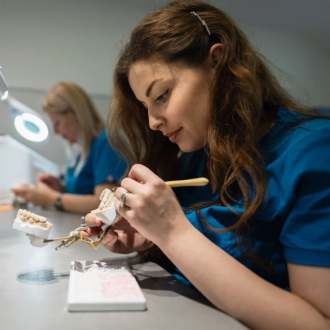
What are Dental Veneers?
Dental veneers are ultra-thin, custom-made shells of tooth-colored materials designed to cover the front surface of teeth to improve their appearance. They are used to fix teeth that are discolored, chipped, broken, or misaligned. Veneers can also be used to close gaps between teeth or make teeth look longer. Veneers are made from materials like porcelain or composite resin and can last for several years with proper care.
How Long can Veneers Last?
Veneers can last for many years, depending on the type of material used.Porcelain veneers are the most durable, and can last up to 10 years with proper care and maintenance. Composite veneers are less expensive and tend to last between 5-7 years.Good oral hygiene, regular check-ups with your dentist, and avoiding habits such as nail-biting or grinding your teeth can help extend the life of your veneers.


What Kind of Tooth Preparation is involved?
The preparation for a dental veneer typically involves removing a very small amount of the surface of the tooth in order to make room for the veneer. The dentist will also shape the tooth to allow for the proper fit and placement of the veneer.
How many visits are required?
The number of visits required for veneers will vary depending on the type of veneers being placed and the complexity of the case. Generally, veneers require two visits.The first visit involves preparation of the teeth, taking impressions, and placing temporary veneers. The second visit involves placement of the permanent veneers.

- • Improve the appearance of teeth
Dental veneers are an effective way to improve the overall appearance of teeth,covering up any discoloration, chips, or gaps.
- • Stain-resistant
Unlike natural teeth, dental veneers are stain-resistant, allowing them to remain white and bright for years.
- • Durable
Dental veneers are made of strong and durable materials, making them a long-lasting solution for improving the appearance of teeth.
- • Quick application
Compared to other cosmetic dental treatments, dental veneers can be applied in a single appointment.
- • Comfortable
Dental veneers are designed to fit comfortably and seamlessly over natural teeth,which is why many patients find them to be a comfortable and convenient solution for improving the appearance of their smile.
- • Composite Bonding
This is a procedure where a tooth-colored composite material is applied to the teeth and hardened with a curing light. It can be used to repair chips, cracks,and discolored teeth.
- • Dental Crowns
These are made from porcelain or other materials, and are cemented onto the tooth.They are used to cover and protect teeth that are cracked, broken, or otherwise damaged.
- • Teeth Whitening
This is a procedure used to lighten and brighten discolored teeth. It uses a bleaching solution that is applied to the teeth.
- • Orthodontics
This is a procedure used to straighten teeth. It involves the use of braces or other appliances to gradually move the teeth into their desired position.
- • Dental Implants
These are used to replace missing teeth. They are artificial roots made from titanium that are implanted in the jawbone, and a crown is then placed on top.
- The consequences of not getting a root canal treatment can include:
- • Brush your teeth twice daily with a soft toothbrush and fluoride toothpaste to remove plaque and bacteria.
- • Floss at least once a day to remove plaque and debris from between your teeth.
- • Avoid biting or chewing hard foods, such as ice or hard candy, to prevent chipping or cracking the veneers.
- • Avoid grinding or clenching your teeth to prevent damage to theveneers.
- • Visit your dentist regularly for checkups and cleaning to ensure that your veneers stay in good condition.
- • Avoid using tobacco products, which can cause staining and discoloration of the veneers.
- • No, attaching veneer is generally not painful. Veneer is usually attached using a dental adhesive, and the procedure is usually done without using anesthesia. The process is usually quick and painless.



